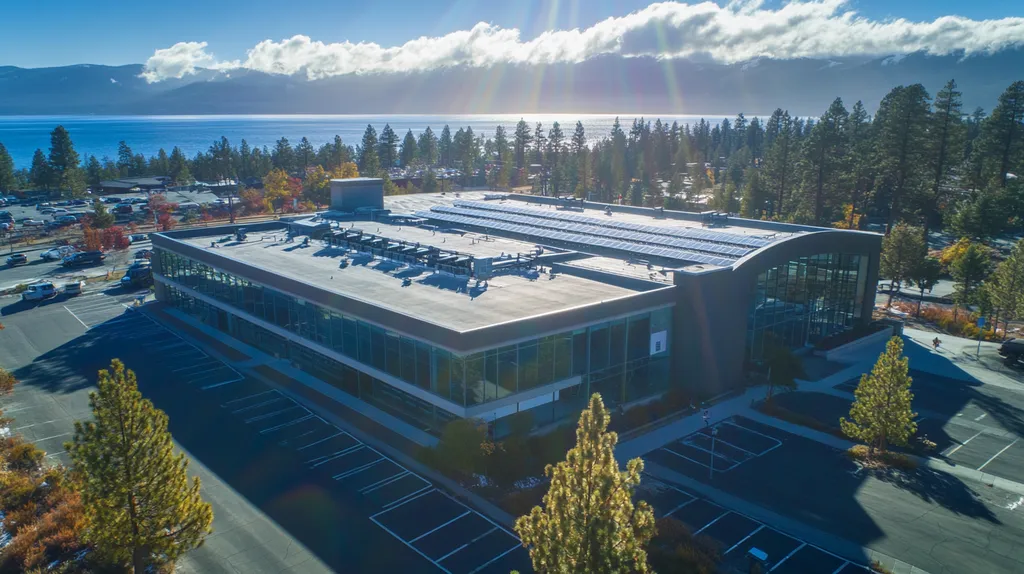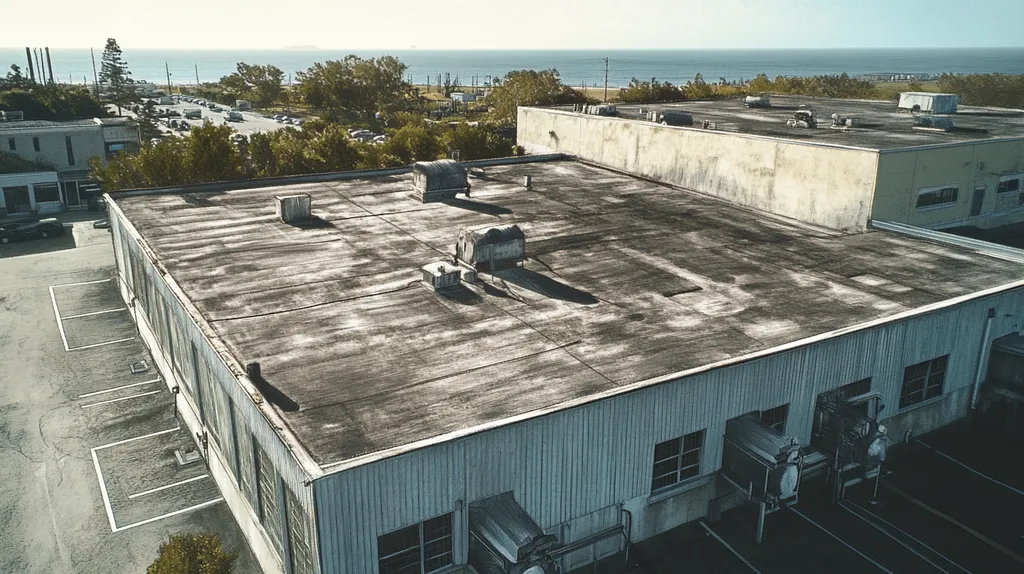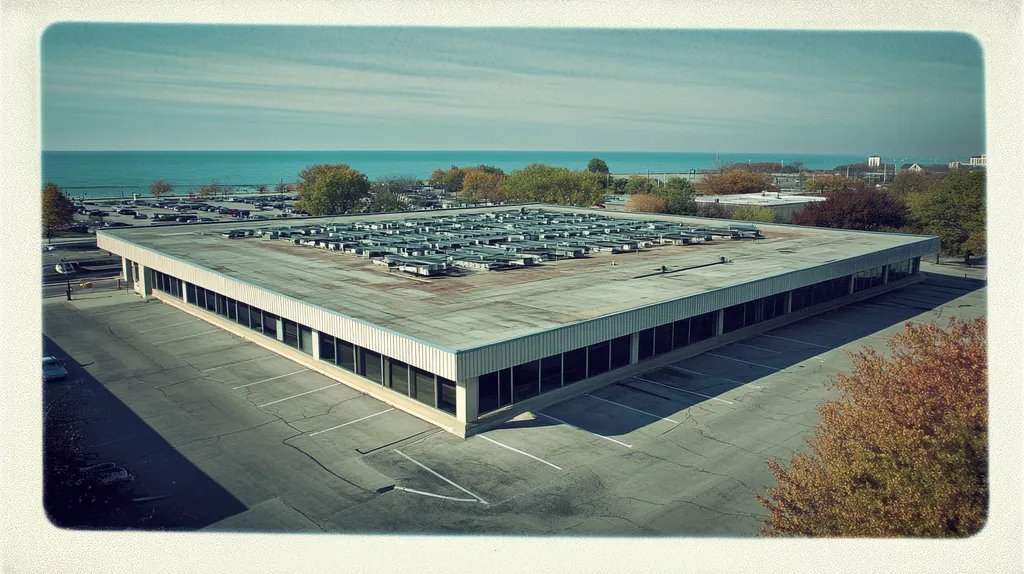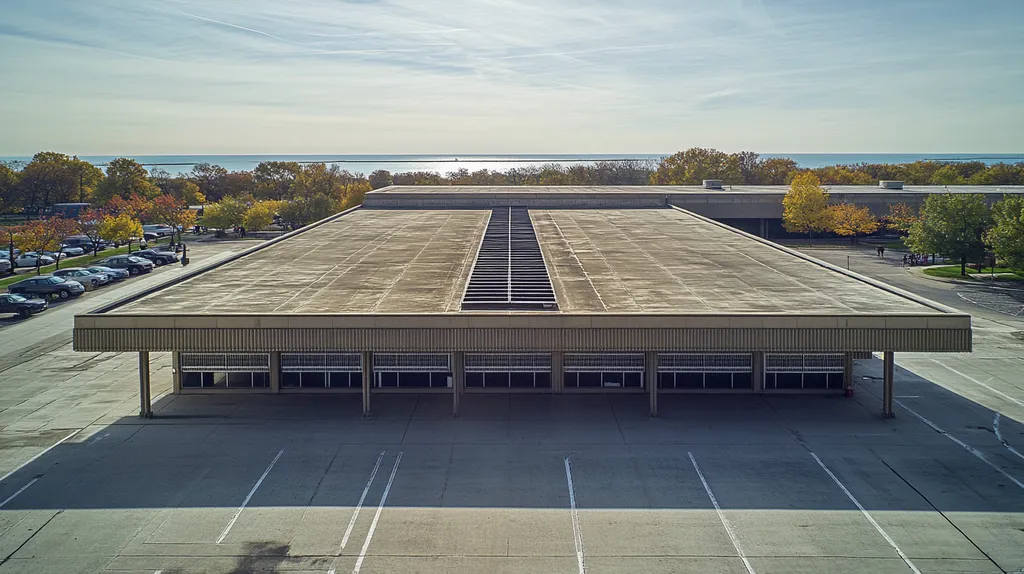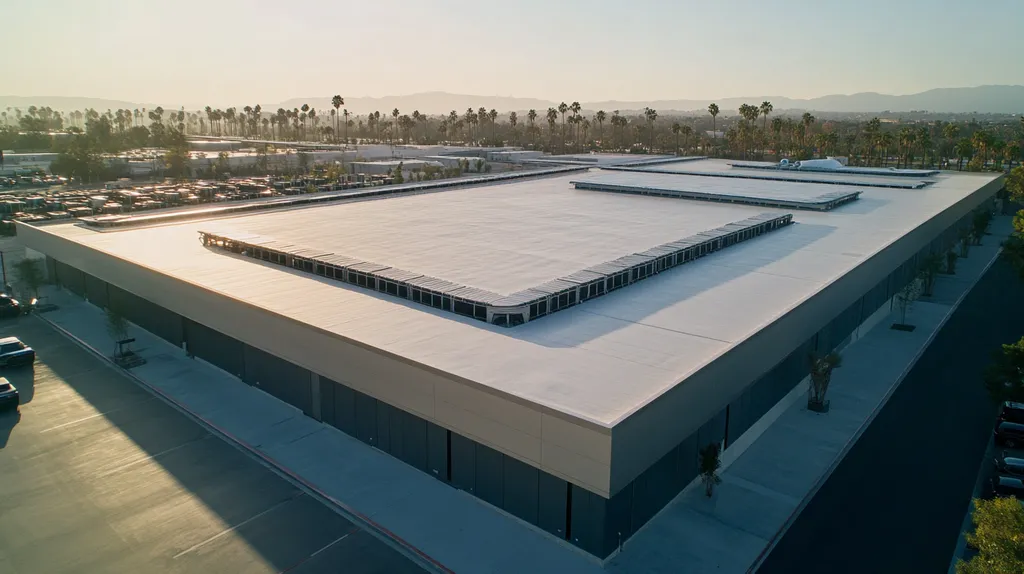Material incompatibility causes over $2 billion in annual roofing failures across industrial facilities, yet 70% of property managers overlook essential compatibility testing during installations and repairs.
From chemical reactions between membranes to structural degradation from mismatched materials, these preventable failures compromise building integrity and operational continuity.
This analysis examines widespread misconceptions about material compatibility, explores evidence-based testing protocols, and provides facility managers with actionable solutions to protect their roofing investments.
SECTION 1: COMMON MISCONCEPTIONS
The world of industrial roofing is filled with misconceptions that can lead to significant financial setbacks and operational issues. Many property owners mistakenly believe that all roofing materials will work together seamlessly, leaving them vulnerable to premature failures. Research from the National Roofing Contractors Association indicates that almost 30% of roofing problems result from material incompatibility. This section clarifies three prevailing misconceptions that could threaten the durability and effectiveness of industrial roofs, making it essential for property managers to recognize them when planning maintenance and upgrades.
Assuming Universal Compatibility
The first misconception is the assumption that all roofing materials are universally compatible. This belief can be dangerous, as different materials have individual chemical properties that may not interact favorably. For example, using PVC membranes in conjunction with certain adhesives can result in degradation of the material.
Facility managers may think that simply layering new materials over existing roofing will solve their problems. However, this can create a multitude of issues, including leaks and compromised structural integrity. Conducting compatibility testing is critical before any installation to avert such adverse outcomes.
Applying a new coating over an old system without proper testing can trap moisture, hastening the rate of deterioration. What appears to be a cost-effective solution may, in reality, lead to substantial financial burdens down the line.
Established industry standards emphasize that compatibility assessments are vital. Overlooking this essential step can undermine the entire lifecycle of a roof, making material synergy not merely a suggestion but a necessity for long-term success.
Ignoring VOC Migration Effects
Another prevalent misconception is the lack of awareness surrounding volatile organic compounds (VOCs) and their effects on roofing materials. Many industry professionals do not understand how VOCs interact with the roofing system, which can severely compromise material integrity.
VOCs emitted from materials like coatings or adhesives can migrate into neighboring components, leading to softening and deterioration. For example, a roofing adhesive might contain VOCs that can degrade nearby insulation. This oversight can result in unexpected replacement costs and prolonged operational downtimes.
Moreover, environmental factors such as heat and humidity can worsen VOC migration. If these conditions are not taken into consideration, property owners risk encountering sudden roof failures during critical operational phases. Ignoring VOC interactions can have serious repercussions.
Incorporating VOC compatibility tests into the roofing process is imperative. Neglecting to do so not only jeopardizes the roofing system but also threatens the overall safety and efficiency of the building.
Overlooking Adhesion Failures
Lastly, overlooking adhesion failures represents a common misconception within the roofing industry. Many facility managers believe that correct application techniques guarantee adhesion, disregarding the crucial role of material compatibility in this process. The chemical makeup of the materials significantly impacts adhesion quality.
A frequent error is applying an EPDM membrane over an incompatible substrate. This mismatch can lead to poor adhesion and severe leaks within a short time frame, resulting in unanticipated repair costs for property owners.
Environmental factors like moisture and temperature can further weaken the bond between materials. A strong initial adhesion can deteriorate if the chosen materials do not complement one another, potentially creating hazardous conditions for the building and its occupants.
Conducting thorough adhesion tests is vital to avoid these failures. Property managers should prioritize material compatibility to ensure a reliable and durable roofing system. Investing time and resources to understand these interactions is crucial for long-term viability and success.
SECTION 2: PRACTICAL IMPLICATIONS
The choice of roofing materials carries significant immediate and long-term repercussions for industrial properties. Compatibility tests are not just an administrative checkbox; they are essential for extending roof life and avoiding costly repairs. According to the National Roofing Contractors Association, roofs that are improperly maintained can lose up to 15 years of their potential lifespan. Recognizing the practical implications of material compatibility is crucial for property owners and facility managers alike.
Impact on Roof Lifespan
The lifespan of a roof is heavily influenced by how compatible the materials are. When incompatible materials are combined, they may interact negatively, accelerating deterioration. For example, using an incompatible roofing membrane with existing insulation can cause premature failure, leading to a full replacement much sooner than anticipated.
By conducting regular compatibility testing, property managers can identify potential issues before they escalate. This proactive approach ensures that materials work together effectively, enhancing durability and prolonging the roof’s overall lifespan. Investments in compatibility assessments pay off by preventing thousands of dollars in unexpected replacement costs.
Additionally, a roof’s longevity directly impacts a facility’s operational budget. Unforeseen repairs can drain financial resources and disrupt business activities. Thus, maintaining a proactive stance on material compatibility safeguards the organization’s bottom line.
In summary, the influence of material compatibility on roof lifespan is profound. Property owners must prioritize compatibility tests to evade premature failures and costly replacements.
Water and Vapor Leakage Issues
Water and vapor leakage are critical concerns for any industrial roofing system. Incompatible materials can often create pathways for moisture intrusion, leading to severe water damage. For instance, pairing waterproof membranes with non-compatible adhesives could result in leaks that remain undetected, causing extensive harm over time.
Beyond physical damage, moisture intrusion can also promote mold growth and health risks, further complicating matters. Regular compatibility testing plays a key role in preventing these issues by ensuring that all materials work together seamlessly to create a watertight seal.
A well-designed roofing assembly effectively manages vapor transfer as well. Improper configurations can trap moisture, leading to ongoing roofing problems. By addressing these concerns through compatibility tests, facility managers can mitigate risks before they manifest.
Ultimately, proper material selection to avoid water and vapor leakage is vital for maintaining a safe and functional industrial environment.
Structural Integrity Risks
Maintaining structural integrity is paramount in industrial roofing systems. Using incompatible materials can weaken the overall structure, leading to potential safety hazards. For instance, installing a metal roof over a substrate that cannot adequately support its weight can have disastrous long-term consequences.
Furthermore, physical damage to the roof can jeopardize the entire facility’s structural integrity. Even minor incompatibilities can initiate cracking or sagging, leading to more extensive repairs than originally planned. Regular compatibility assessments help mitigate these risks by ensuring that materials are well-suited from the beginning.
Investing in compatibility tests not only protects the roof but also the structure beneath it. Roof collapses due to material failures can result in severe repercussions, including safety hazards and operational downtime.
In conclusion, testing for material compatibility is essential for preserving structural integrity. Ensuring harmonious interactions between all components contributes to safer and more robust industrial facilities.
SECTION 3: COST OF MISINFORMATION
The consequences of misinformation in industrial roofing can be staggering. Misguided assumptions about material compatibility can lead to significant roof failures that cost businesses anywhere from thousands to millions of dollars. Industry estimates suggest that replacing roofs due to compatibility issues can range between $500,000 to over $1 million, depending on the facility’s size and complexity. Therefore, understanding these potential costs is crucial for property owners and facility managers.
Financial Consequences of Failures
The financial ramifications of roofing failures are serious and often unexpected. A failure stemming from incompatible materials can quickly lead to repair costs that reach six figures. Additionally, operational disruptions during repairs can amplify these expenses considerably.
For example, a manufacturing facility dealing with roof leaks may need to halt production, resulting in lost revenue. This situation illustrates how misinformation regarding material compatibility can create a ripple effect, resulting in not just repair costs but also indirect losses due to halted operations.
Therefore, investing in thorough compatibility testing serves as a proactive strategy to protect against these financial pitfalls. Property owners who skip these tests may find themselves facing exorbitant expenses that could have been easily avoided.
In summary, allowing misinformation to influence roofing decisions can precipitate severe financial losses, highlighting the necessity of rigorous compatibility assessments.
Maintenance and Repair Costs
The ongoing maintenance costs of roofing systems can accumulate rapidly when misinformation prevails. Using incompatible roofing materials often leads to premature wear and tear, causing frequent repairs that strain budgets and resources.
For instance, a roof improperly layered with incompatible membranes could demand constant patching or an early replacement, effectively doubling expenditure for property managers. Regular maintenance costs should ideally be predictable; however, misinformation can transform them into an unpredictable financial burden.
Conducting compatibility tests prior to installation can minimize the danger of encountering significant maintenance challenges down the road. A small investment in these assessments now can yield substantial savings later, fostering a resilient structure and ensuring budget stability.
As such, the ongoing financial burden from unexpected maintenance and repair needs illustrates the costly mistake of disregarding misinformation.
Potential Legal Liabilities
The legal consequences of misjudging material compatibility can be severe and expansive. Property owners may face lawsuits due to damages caused by inadequate roofing systems, including breaches of warranty or failure to meet building codes. Legal challenges can consume valuable resources, leading to further financial losses.
For instance, if a roof failure results in damage to nearby buildings or injuries to employees, costly litigation can ensue. In these scenarios, property owners could be liable for damages that extend far beyond simple repair costs, compromising their business’s overall financial health.
Moreover, insurance claims may not cover damages arising from negligence in roofing decisions. If insurers find that a property owner chose materials without adequate compatibility testing, they may rightfully contest claims, leaving the owner financially vulnerable.
In conclusion, property owners must recognize that the costs of misinformation extend beyond immediate material expenses, resulting in significant legal liabilities that can jeopardize their business’s future.
SECTION 4: REALITY CHECK
The selection of roofing materials is critical not just for immediate aesthetics but also for the long-term durability and efficiency of a roof system. Incompatibility among materials can lead to costly repairs or even premature roof failure, with a staggering 20% of roof leaks attributed to material-related issues. Therefore, understanding material compatibility is essential for making informed decisions and effectively managing risks associated with industrial roofing.
Importance of Material Compatibility
Ensuring material compatibility is vital for extending the lifespan and performance of a roofing system. Incompatible materials can engage in negative interactions that lead to leaks, deterioration, or even structural failures. For example, adhesives that do not properly bond with specific membrane types can create weak points within the system, increasing vulnerability to leaks.
Additionally, the impacts of poor compatibility extend beyond visible issues. They can also influence energy efficiency and indoor air quality, ultimately affecting the overall comfort of the building. Conducting compatibility tests prior to installation can identify potential problems early, saving both time and money.
Recognizing the significance of material compatibility encourages a proactive approach among property owners. By understanding these risks, they can avoid costly pitfalls associated with mismatched materials that could surface years later.
Overall, ensuring compatibility is not just an operational best practice; it is a wise investment in the future integrity of a facility’s roofing system.
Role of Climatic Testing
Climatic testing is an essential factor when evaluating material compatibility. Each climate presents unique challenges, which means a material that performs well in one environment might fail in another. For instance, membranes designed for humid climates may not withstand the harshness of arid, sunny conditions.
By conducting climatic tests, property owners can determine how materials will respond to different environmental stresses, ensuring long-term performance. These tests also help predict how roofing components will behave under various weather conditions, allowing for more informed decisions during material selection.
Facilities managers can leverage these insights to choose the best materials for their specific climate, directly reducing the risk of weather-related damage. Making climatic considerations a priority leads to improved roof lifespan and organization investment protection.
Incorporating climatic testing thus enables data-driven decisions, reinforcing the overall integrity and performance of the roofing system.
Supplier-Verified Compatibility
Supplier-verified compatibility serves as an important safety net when selecting materials. Many manufacturers conduct their own thorough compatibility tests and provide verified documentation to back up their claims. This not only adds credibility to the material selection process but also helps property owners avoid costly errors.
There are numerous instances where facilities have chosen materials based on anecdotal evidence, only to face a myriad of problems later due to compatibility flaws. Relying on supplier-verified compatibility reduces such risks significantly.
Moreover, reputable suppliers tend to offer comprehensive documentation that details how their materials interact with others. This level of transparency aids facility managers in making informed, educated choices that lead to better roofing outcomes.
Ultimately, partnering with trusted suppliers leads to more reliable material selection, helping to minimize future complications and enhance the durability of roofing systems.
SECTION 5: EVIDENCE-BASED ALTERNATIVES
The importance of material compatibility in industrial roofing cannot be overstated. Inadequate material choices can lead to costly leaks, sagging, and even safety hazards. Studies indicate that up to 30% of industrial roofs fail prematurely due to material incompatibility. Property owners and facility managers must embrace standardized testing methods and comply with ASTM guidelines to ensure reliable roofing systems. This section explores evidence-based alternatives that enhance roofing performance while minimizing risks.
Standardized Testing Methods
Standardized testing methods are essential for evaluating the compatibility of roofing materials. These tests measure how materials respond to conditions such as temperature changes and moisture exposure. By adhering to established testing protocols, property managers can predict the long-term performance of their roofs more effectively.
Techniques like peel adhesion tests and shear strength evaluations provide concrete data on material interactions. This kind of scientific evaluation helps avoid unpleasant surprises that can result from relying solely on experience or guesswork. Incorporating these testing measures leads to roofs that are better equipped to withstand real-world conditions.
For example, one facility manager who employed standardized tests before installation was able to select materials that significantly enhanced the roof’s durability. This proactive step not only improved operational efficiency but also protected valuable investments.
Using standardized testing not only reduces risks but also strengthens compliance with building regulations. This approach ensures property owners meet necessary legal standards, providing peace of mind in their roofing choices.
ASTM Guidelines for Roofing Materials
ASTM (American Society for Testing and Materials) outlines critical guidelines for evaluating roofing materials. These recommendations cover various aspects, including thermal performance and weather resistance, helping property owners confirm material compatibility.
For instance, ASTM D7281 focuses on the interaction between roofing materials and expanded polystyrene foam, shedding light on potential degradation issues. Adhering to these guidelines contributes to longer-lasting roofs and improved safety for occupants.
Additionally, following ASTM guidelines can facilitate obtaining warranties from manufacturers. These warranties offer additional protection for property owners, minimizing future financial liabilities associated with roofing complications.
By prioritizing ASTM compliance, facility managers can make well-informed decisions that enhance the structure’s longevity and safeguard overall budget considerations over time.
Case Studies of Successful Compatibility
Real-world examples underscore the importance of material compatibility in roofing performance. One factory, dedicated to conducting thorough compatibility tests before installation, was able to choose materials that met ASTM standards and thrived in their specific operational environment.
This diligence resulted in a 40% reduction in maintenance costs over five years due to increased material lifespan and a decrease in leaks. Such results illustrate how making informed choices based on compatibility data can yield significant savings and bolster safety.
Another case involved a distribution center plagued by roofing problems. By implementing compatibility tests recommended by ASTM, management identified unsuitable materials and made a switch to scientifically validated options, leading to a noticeable decline in repair needs.
These case studies highlight a key principle: informed decision-making based on compatibility testing can substantially enhance roofing outcomes and performance. They serve as strong evidence of the benefits of aligning material choices with established scientific standards.
SECTION 6: TEST AND VERIFY
In the high-stakes world of industrial roofing, neglecting proper compatibility tests can result in severe ramifications, including unexpected roof failures and costly repairs. Research indicates that roofs lacking these essential tests face a 30% increased likelihood of leaks within just five years. This section emphasizes the necessity of rigorous testing protocols to secure dependable and durable roofing solutions.
Shear and Peel Resistance Tests
Shear and peel resistance tests are essential for determining how roofing materials will perform under stress. These tests simulate real-world forces such as wind uplift and thermal expansion that roofs frequently encounter.
When materials are incompatible, they risk delamination, which can compromise structural integrity. These tests measure the bond strength between layers and provide critical information that can prevent costly roof failures.
A recent project involving a flexible membrane system highlighted the consequences of poor peel strength, which led to early detachment from the substrate, resulting in expensive repairs just months post-installation.
By implementing standardized shear and peel resistance tests, facility managers can make informed choices about material selection, promoting durability and reliable operational performance.
Cyclic Fatigue and Adhesion Tests
Cyclic fatigue tests evaluate how materials hold up against repetitive stresses over time, a crucial factor for roofs that experience continuous thermal cycling or vibrations from heavy equipment.
These tests assess the adhesion quality among roof components. Poor adhesion can lead to leaks, resulting in severe consequences like mold growth and structural damage.
An example underscores this risk: a factory experienced extensive internal damage when inadequate adhesion allowed moisture to seep in, leading to repair costs soaring into the tens of thousands.
Conducting cyclic fatigue and adhesion tests helps property owners make well-informed decisions about material choices, ensuring they can withstand the rigors of time and environmental stresses.
Regular Inspection and Monitoring Protocols
Regular inspections and systematic monitoring are crucial for maintaining roof integrity after installation. These practices enable facility managers to catch early signs of material incompatibility before they escalate into larger problems.
Visual inspections can identify issues like blistering or bubbling, while advanced tools like thermal imaging can detect hidden problems resulting from thermal inconsistencies.
Establishing a preventive maintenance schedule that includes regular monitoring not only extends the life of the roof but also minimizes disruptions to business activities. Facilities with robust inspection protocols report 60% fewer costly repairs.
Integrating these practices into overall facility management ensures that roofing decisions are informed by data and responsive to evolving conditions. This proactive strategy safeguards investments and supports sustained performance.
The Bottom Line
With over $2 billion in annual roofing failures linked to material incompatibility, the evidence demands a shift toward rigorous testing protocols across the industrial roofing sector.
The data consistently shows that facilities implementing comprehensive compatibility testing experience 40% fewer failures and save an average of $350,000 in premature replacement costs.
Moving forward, property managers must prioritize ASTM-approved testing methods, supplier verification, and regular monitoring to protect their investments.
The cost of ignoring material compatibility far exceeds the investment in proper testing, often by a factor of ten or more when accounting for repairs, downtime, and potential liability.
As roofing systems become more complex, the importance of material compatibility testing will only increase, making it an essential cornerstone of responsible facility management.
FREQUENTLY ASKED QUESTIONS
Q. What are common misconceptions about commercial roofing materials?
A. Many believe all materials are universally compatible, which is inaccurate. Using materials without considering their chemical interactions can lead to significant failures. Additionally, some overlook the need for compatibility testing, which is crucial to prevent premature roof issues.
Q. How does material compatibility affect an industrial roof’s lifespan?
A. The lifespan of a roof can be significantly shortened by incompatible materials. When materials do not work well together, they may deteriorate faster, leading to costly repairs or replacements. Regular compatibility testing can prolong roof life by identifying potential issues early.
Q. What are the financial impacts of misinformation on industrial roofs?
A. Misinformation about material compatibility can lead to costly roof failures, often resulting in unexpected expenses reaching six figures. These failures can also disrupt operations, compounding financial losses with potential downtime and repair costs that exceed initial estimates.
Q. Why is material testing vital for preventing leaks in commercial roofs?
A. Testing ensures that all roofing materials work together effectively, minimizing the risk of leaks. Incompatible materials can create pathways for moisture intrusion. Regular compatibility assessments prior to installation help safeguard against such issues, promoting a watertight roofing system.
Q. What are standardized testing methods for commercial roofing materials?
A. Standardized testing methods evaluate material performance under conditions like thermal exposure and moisture. Tests like peel adhesion and shear strength provide valuable data on how materials interact, helping facility managers choose the best options to ensure roofing durability.
Q. How can climatic testing influence my commercial roof’s performance?
A. Climatic testing evaluates how materials perform in different environmental conditions. It helps identify the best materials for your specific climate, ensuring long-term performance and reducing risks associated with weather-related damage. This proactive approach supports overall roofing efficiency and durability.
Q. What new testing protocols should I consider for my industrial roof?
A. New protocols include shear and peel resistance tests that simulate real-world conditions and cyclic fatigue tests to evaluate material endurance under stress. Implementing these techniques helps identify potential weaknesses, ensuring that selected materials will maintain integrity over time.


